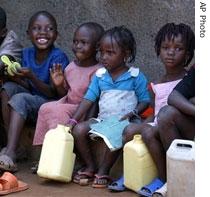-
(单词翻译:双击或拖选)
Every day, more than two thousand children worldwide die from accidental injury. Each year, as many as three million children are saved from one leading cause of child deaths -- drowning. Yet survivors1 can suffer brain damage. As a result, the lifetime health and economic costs of a non-fatal drowning are the highest on average of any kind of injury.
These are among the findings in the "World Report on Child Injury Prevention." The new report is the first of its kind from the World Health Organization and UNICEF.
Doctor Etienne Krug at the W.H.O. says that every year, eight hundred thirty thousand children die from accidental injuries.
ETIENNE KRUG: "It’s like wiping out every year the whole population of children in Chicago or a city like Marseilles. It’s a very big public health issue, which, unfortunately, has been ignored for too long. The main causes of child unintentional injuries are road traffic crashes, drowning, burns, falls and poisoning."
Poor children everywhere are most at risk. But the report's top editor, Margie Peden, says more than ninety-five percent of child injuries happen in developing nations.
 |
| Children in Uganda |
MARGIE PEDEN: "Africa, unfortunately, has the highest rate of all these accidental injuries, unintentional injuries. In particular, road traffic injuries, as well as poisoning. One of the reasons for that is because many people in Africa are still dependent on paraffin or kerosene2 for heating and lighting3."
The report says Africa's death rate is ten times higher than in wealthier countries in Europe and the Western Pacific. Countries such as Australia, the Netherlands, New Zealand, Sweden and Britain have the lowest rates of child injury. Yet even in high-income countries, accidental injuries still cause forty percent of all child deaths.
The report says at least one thousand young lives could be saved every day if a few simple measures were taken everywhere.
These include requiring children to wear seatbelts in cars and helmets on bikes. Limiting the temperature of hot water systems could prevent burns. And water should not be left standing4 in baths or buckets where small children could drown. Medicine bottles, lighters5 and household product containers should have child resistant6 closures.
Yet the report warns that even a safety measure like airbags in the front seat of a car could harm children under age thirteen. And it advises people not to use traditional home treatments like butter, sugar or oil on burns.
And that's the VOA Special English Health Report, written by Caty Weaver7 with reporting from Lisa Schlein in Geneva. I’m Barbara Klein.
 收听单词发音
收听单词发音
1
survivors

|
|
| 幸存者,残存者,生还者( survivor的名词复数 ) | |
参考例句: |
|
|
|
2
kerosene

|
|
| n.(kerosine)煤油,火油 | |
参考例句: |
|
|
|
3
lighting

|
|
| n.照明,光线的明暗,舞台灯光 | |
参考例句: |
|
|
|
4
standing

|
|
| n.持续,地位;adj.永久的,不动的,直立的,不流动的 | |
参考例句: |
|
|
|
5
lighters

|
|
| n.打火机,点火器( lighter的名词复数 ) | |
参考例句: |
|
|
|
6
resistant

|
|
| adj.(to)抵抗的,有抵抗力的 | |
参考例句: |
|
|
|
7
weaver

|
|
| n.织布工;编织者 | |
参考例句: |
|
|
|

















